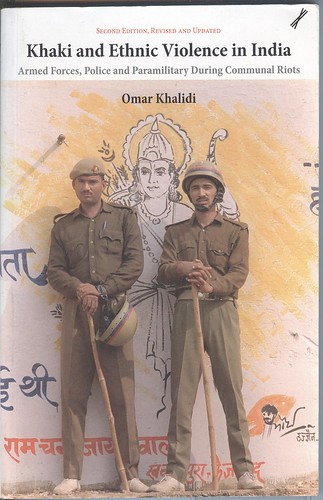By Mahtab Alam, TwoCircles.net,
Name of the book: Khaki & Ethnic Violence in India
Author: Omar Khalidi
Publisher: Three Essays Collective
B-957 Palam Vihar, Gurgaon, Haryana-122 017, India
Phone: +91 98681 26587, +91 91863 44843
Year: 2010 (2nd and Revised edition)
Pages: 196
Price: Rs. 300/-
In January 2006, L.K. Advani, then Leader of Opposition in Lok Sabha, the lower house of the Indian Parliament, walked out from the house. The reason? Muslim headcount in the Army as proposed by Sachar Committee. But, why this much hue and cry over a simple matter and walkout? Was there anything to hide? Why Mr. Advani & Company was so afraid by Muslim headcount in Indian Army? The book under review can give you an idea, why it could have been?

This book covers a wider theme of the religious composition of the armed forces, the paramilitary and the police and documents data on marginal representation of Muslims in the Army and other Security & Intelligence Services especially on decisive positions till 2008. In fact, it answers some of the crucial questions like – Who runs India’s security sector consisting of ministries of home, intelligence and defence affairs? The book is written by Dr. Omar Khalidi, an independent scholar and a staff member at the Massachusetts Institute of Technology (MIT), United States of America.
Colonial Hangover
Tracing the changes and continuity in recruitment and other policies in the Army both in colonial period and since the Independence, the author concludes, “As noted before, just before independence the colonial administration agreed to throw open the army to Indians of all the caste and communities… (H)owever, in practice, the matter remained where it was.” (p. 37). And this claim is fully backed by data. He further points, “It is interesting to note that during the colonial era, the army used Urdu written in Roman letters to “solve” the language issues by using neither Devnagari nor Urdu script for written communication. In post-independence era, Sanskritized Hindi replaced Urdu, exemplified by the title change of military news magazine Fauji Akhbar to Sainik Samachar !” (p. 44)
Saffronisation of Army?
The author poses questions like: What is the influence of the ideology of Hindutva in the armed forces?, Do the majority of the rank and file share the Hindutva vision of India? And will the military remain the last reliable line of defence in worsening communal relations, since the police uniforms are tainted with partnership. To answer, the author quotes J. S Nadkarani, “Sympathy for Hindutava is far more wide spread amongst senior officers than was suspected. One has reason to believe that under their immaculate uniforms, a large number of senior officers wear saffron vest. It is quite easy to spot them. They invariably start their conversation by stating that they are really secular at heart. They have never believed in caste or creed. But one must be fair. Don’t you think we are pampering the Minorities? ” (p. 79). The author’s suspicion grows as he sees some 50 top retired officers of the army, navy and air force joining BJP between May 1991 and March 1998 stating the typical ‘nationalistic’ reasons: BJP’s tough stand against minorities and Pakistan. He also cites the incident of 31 May 1999, when the Defence Minister (in BJP led government) took the unprecedented step of taking senior officers to brief the BJP National Executive (p. 80).
Khaki and Communal Violence
One of the most important aspects that the author in this book examines is the impacts of under-representation of ethnic and religious groups especially Muslims in this sector—low percentage in Police and Biased/Partisan/Active Hostility. The author argues, “Even though the police conduct in the riots during the Babri mosque or other similar riots may be dismissed as merely partisanship, dereliction of duty, negligence and so forth, there are a number of instances in which the police was the perpetrators of unprovoked violence against innocent and unarmed Muslims. The two notorious cases are from Moradabad in 1980 and Meerut in 1987. Similarly the police was an active participant in the 1992-93 Bombay killings of Muslims as documented by more than one organization. Later in March 1993 and during Gujarat pogrom, February-March 2002, when police took active part in killing or leading the mobs attacking Muslims” (p. 140-41). The author has dealt this issue at length.
Muslim hence ‘Unreliable’
The last but most important chapter of the book documents the structure of communal biasness in intelligence agencies. In 1970, M K Dhar, a former joint director of IB confessed that his anti-Muslim perceptions were further strengthened by what I was thought at the Anand Parvat training facility of the Intelligence Bureau…I was told in no uncertain terms the Muslims were not to be trusted.” (p. 157).The book also details about the un-written policy of non-recruitment of Muslims in Intelligence Services. And former CBI Director, Vijay Karan confirms it “It is a sort of an unwritten code. Everybody knows about it and it is accepted as a fact.” (p. 157) According to senior journalist Saikat Datta, “from 1969 till today the 1,000-strong RAW has avoided recruiting any Muslim officers.” (p. 157) This chapter also deals with the ethnic composition of the Paramilitary Forces, Central Reserve Police and Rapid Action Forces.
Though written in an academic fashion — of course it was needed while writing a book on sensitive issue like this — the language of the book is lucid and easy to read for even a normal reader. The book is an eye opening work in many ways and unravels many popular beliefs like the army and intelligence agencies are secular. The work is must for libraries and research institutions. Civil and human rights activists can hardly afford to miss it.
Link: http://www.threeessays.com/titles.php?id=11

